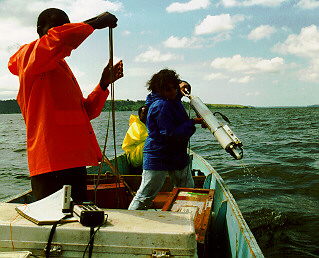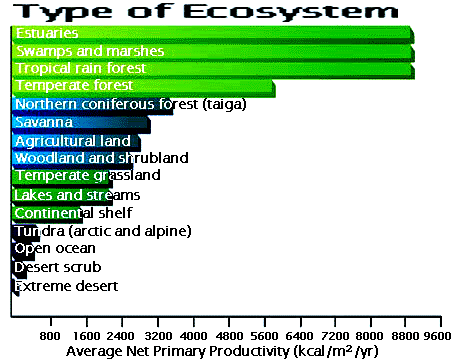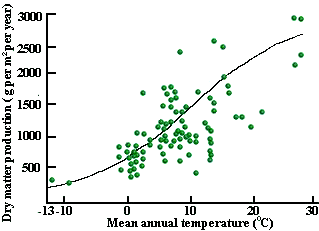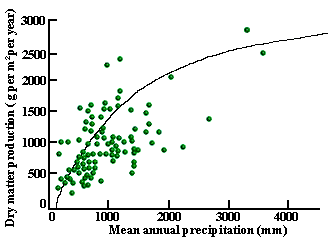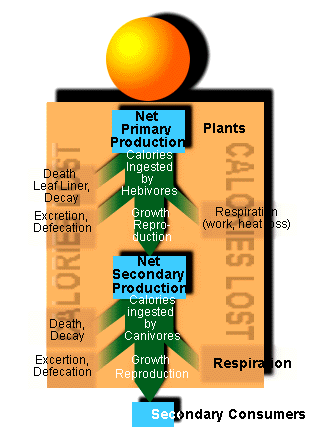In this lesson, we wish to answer these questions:
Introduction - Energy Flows and Material CyclingToday we will explore some of the multiple topics related to the flow of energy in ecosystems. Energy is used up and lost as heat as it moves through ecosystems, and new energy is continually added to the earth in the form of solar radiation. As we learned in the last lecture, the earth is an open system in regard to energy.Nutrients and other materials, on
the other hand, are continually recirculated within and among ecosystems,
and by and large there are no new inputs or losses from the planet. In
terms of materials, then, the earth is a closed system. Both energy and
materials are essential to ecosystem structure, function, and composition.
You have already been exposed to the basic concepts of nutrient cycles;
in this lecture we focus on energy. Note that in terms of the cycling of
carbon, "materials" and energy can be inter-converted. For example, we
know how many calories (a measure of energy) a gram of certain carbon compounds
materials such as fats or carbohydrates contain.
Autotrophs verses Heterotrophs As a brief review, we recognize that some organisms are capable of synthesizing organic molecules from inorganic precursors, and of storing biochemical energy in the process. These are called autotrophs, meaning "self-feeding." Autotrophs also are referred to as primary producers. Organisms able to manufacture complex organic molecules from simple inorganic compounds (water, CO2, nutrients) include plants, some protists, and some bacteria. The process by which they do this usually is photosynthesis, and as its name implies, photosynthesis requires light (see Figure 1).
In this lecture we will begin with
a consideration of primary production, and in the next lecture we will
examine what happens to this energy as it is conveyed along a food chain.
The Process of Primary ProductionThe general term "Production" is the creation of new organic matter. When a crop of wheat grows, new organic matter is created by the process of photosynthesis, which converts light energy into energy stored in chemical bonds within plant tissue. This energy fuels the metabolic machinery of the plant. New compounds and structures are synthesized, cells divide, and the plant grows in size over time. As was discussed in detail in a previous lecture, the plant requires sunlight, carbon dioxide, water, and nutrients, and through photosynthesis the plant produces reduced carbon compounds and oxygen.Whether one measures the rate at
which photosynthesis occurs, or the rate at which the individual plant
increases in mass, one is concerned with primary production (definition:
the synthesis and storage of organic molecules during the growth and reproduction
of photosynthetic organisms). The core idea is that new chemical compounds
and new plant tissue are produced. Over time, primary production results
in the addition of new plant biomass to the system. Consumers derive their
energy from primary producers, either directly (herbivores, some detritivores),
or indirectly (predators, other detritivores).
Is there an Upper Limit to Primary Production?The short answer is "yes". Let's briefly consider how much energy is in fact captured by autotrophs, and examine how efficient is the process of photosynthesis. Recall that the intensity of solar radiation reaching the earth's surface depends partly on location: the maximum energy intensity is received at the equator, and the intensity decreases as we move toward the poles. As we saw in the lecture on ecosystems, these differences have profound effects on climate, and lead to the observed geographic patterns of biomes.Furthermore, we know that only a small fraction of the sun's radiation is actually used in the photosynthetic reaction in plants at the Earth's surface. Of the total solar radiation striking the Earth's outer atmosphere, about half of it is reflected back to space by ice, snow, oceans, or deserts, or absorbed by gases in the atmosphere - for example, the atmosphere's ozone gas layer absorbs nearly all ultraviolet light, which makes up about 9% of the sun's radiation. Overall, of the light that reaches Earth's surface, only about half of it is in the wavelength range that can be used by plants in photosynthesis (~400-700 nm wavelength) - this is called the Photosynthetically Active Radiation, or PAR. Plants strongly absorb light of blue and red wavelengths (hence their green color, the result of reflection of green wavelengths), as well as light in the far infrared region, and they reflect light in the near infrared region. Even if the wavelength is correct, the light energy is not all converted into carbon by photosynthesis. Some of the light misses the leaf chloroplast, where the photsynthetic reactions occur, and much of the energy from light that is converted by photosynthesis to carbon compounds is used up in keeping the plant biochemical "machinery" operating properly - this loss is generally termed "respiration", although it also includes thermodynamic losses. Plants do not, then, use all of the light energy theoretically available to them (see Figure 2).
On average, plant gross primary production
on earth is about 5.83 x 106 cal m-2 yr-1.
This is about 0.06% of the amount of solar energy falling per square meter
on the outer edge of the earth's atmosphere per year (defined as the solar
constant and equal to 1.05 x 1010 cal m-2 yr-1).
After the costs of respiration, plant net primary production is reduced
to 4.95 x 106 cal m-2 yr- 1, or about
0.05% of the solar constant. Note that this is the "average" efficiency,
and in land plants this value can reach ~2-3% and in aquatic systems this
value can reach ~1%. This relatively low efficiency of conversion of solar
energy into energy in carbon compounds sets the overall amount of energy
available to heterotrophs at all other trophic levels. Some Definitions So far we have not been very precise about our definitions of "production", and we need to make the terms associated with production very clear. * Gross Primary Production, GPP, is the total amount of CO2 that is fixed by the plant in photosynthesis. * Respiration, R, is the amount of CO2 that is lost from an organism or system from metabolic activity. Respiration can be further divided into components that reflect the source of the CO2. Rp =Respiration by Plants Rh = Respiration by Heterotrophs Rd =
Respiration by Decomposers (the microbes)
* Net Primary Production,
NPP, is the net
amount of primary production after the costs of plant respiration are included.
Therefore, NPP = GPP - R
A measure of Net Ecosystem Production is of great interest when determining the CO2 balance between various ecosystems, or the entire earth, and the atmosphere. Note that in these definitions we are concerned only with "primary" and not "secondary" production. Secondary production is the gain in biomass or reproduction of heterotrophs and decomposers. The rates of secondary production, as we will see in a coming lecture, are very much lower than the rates of primary production. Measuring Primary ProductionYou may already have some idea of how one measures primary production. There are two general approaches: one can measure either (a) the rate of photosynthesis, or (b) the rate of increase in plant biomass. Will they give the same answer?(a) Rate of Photosynthesis: You know the equation for photosynthesis from a previous lecture: 6 CO2+ 6 H2O à sunlight à C6H12O6 + 6 O2 If we could place our plants in a closed system, and measure the depletion of CO2 per unit time, or the generation of O2, we would have a direct measure of primary production. The method used in studies of aquatic primary production illustrates this method well. In the surface waters of lakes and oceans, plants are mainly unicellular algae, and most consumers are microscopic crustaceans and protozoans. Both the producers and consumers are very small, and they are easily contained in a liter of water. If you put these organisms in a bottle and turn on the lights, you get photosynthesis. If you turn off the lights, you turn off the primary production. However, darkness has no effect on respiration. Remember that cellular respiration is the reverse process from photosynthesis. C6H12O2 -------- 6 CO2 + 6 H2O Photosynthesis stores energy, and respiration releases it for use in functions such as reproduction and basic maintenance. When calculating the amount of energy that a plant stores as biomass, which is then available to heterotrophs, we must subtract plant respiration costs from the total primary production. The general procedure is so simple that primary production of the world's oceans has been mapped in considerable detail, and many of the world's freshwater lakes have also been investigated (Figure 3). One takes a series of small glass bottles with stoppers, and half of them are wrapped with some material such as tinfoil so that no light penetrates. These are called the "light" and "dark" bottles, respectively.
Figure 3. "Limnologists"
(people who study lakes and streams) working
The bottles are filled with water taken from a particular place and depth; this water contains the tiny plants and animals of the aquatic ecosystem. The bottles are closed with stoppers to prevent any exchange of gases or organisms with the surrounding water, and then they are suspended for a few hours at the same depth from which the water was originally taken. Inside the bottles CO2 is being consumed, and O2 is being produced, and we can measure the change over time in either one of these gases. For example, the amount of oxygen dissolved in water can be measured easily by chemical titration. Before suspending the bottles, the initial O2 concentration is determined and expressed as mg of O2 per Liter of water (mg/L). Then, the final value is measured in both the light and dark bottles after a timed duration of incubation. What processes are taking place in each bottle that might alter the original O2 or CO2 concentrations? The equations below describe them. Light bottle: In the light bottle there is photosynthesis, or Gross Primary Production (GPP), and there is Respiration (R). The difference between these two processes, as we saw above, is Net Primary Production = NPP = (GPP - R) Dark bottle: In the dark bottle there is no photosynthesis and only respiration. (In this example we may also have some consumer respiration in both bottles, unless we used a net to sieve out tiny heterotrophs.) Now consider the following simple example. It illustrates how we account for changes from the initial oxygen concentrations in the water that occurred during the incubation. We will assume that our incubation period was 1 hour. Measured oxygen concentrations: Initial bottle = 8 mg O2 /L ; Light bottle = 10 mg O2 /L ; Dark bottle = 5 mg O2 /L The oxygen increased in the light bottle compared to the initial due to photosynthesis, and the oxygen decreased in the dark bottle due to respiration. With this information we can calculate the Respiration, NPP, and GPP for our system: (Light - Initial) = (10 - 8) = 2 mg/L/hr = (GPP - R) = NPP (Initial - Dark) = (8 - 5) = 3 mg/L/hr = Respiration (Light - Dark) = (10 - 5) = 5 mg/L/hr = (NPP + R) = GPP Thus we have a measure of the net and gross primary production as well as the respiration of our system. The oxygen technique is limited in situations where the primary production is very low. In these situations, the radioactive form of carbon, C14 (14CO2), can be used to monitor carbon uptake and fixation. You can also convert the results between the oxygen and carbon methods by multiplying the oxygen values by 0.375 to put them into carbon equivalents (the factor comes from differences in atomic mass). (b) Rate of Biomass Accumulation: What do you do with plants that are too large to put in bottles? Consider the following example. Suppose we wish to know the primary production of a corn crop. We plant some seeds, and at the end of one year we harvest samples of the entire plants including the roots that were contained in one square meter of area. We dry these to remove any variation in water content, and then weigh them to get the "dry weight". Thus our measure of primary production would be grams m-2 yr-1 of stems, leaves, roots, flowers and fruits, minus the mass of the seeds that may have blown away. What have we measured? It isn't GPP, because some of the energy produced by photosynthesis went to meet the metabolic needs of the corn plants themselves. Is it NPP? Well, if we excluded all the consumers such as insects of the corn plant, we would have a measure of NPP. But we assume that some insects and soil arthropods took a share of the plant biomass, and since we did not measure that share, we actually have measured something less than NPP. Note that this is exactly the same situation in the bottle method we described above if small heterotrophs that grazed on algae were included in the bottle, in which case the two methods would measure the same thing. In recent years it has also become possible to estimate GPP and R in large plants or entire forests using tracers and gas exchange techniques. These measurements now form the basis of our investigations into how primary production affects the carbon dioxide content of our atmosphere. Production, Standing Crop, and TurnoverWith either of these methods, the primary Production can be expressed as the rate of formation of new material, per unit of earth's surface, per unit of time. The production is reported as calories/m2/year (energy) or grams/m2/year (dry organic matter).Standing crop, on the other hand, is a measure of the biomass of the system at a single point in time, and is measured as calories or grams per m2. The difference between production and standing crop is a crucial one, and can be illustrated by the following question. Should a forester, interested in harvesting the greatest yield from a plot, be more interested in the forest's standing crop or its primary production? Well, the key element to the answer is "TIME". If the forester wants a short term investment (i.e., to cut the forest down), then the higher the standing crop the better. If instead the forester wants to manage the forest over time, then the rate at which the forest produces new biomass is critical. The ratio of the standing crop to the production (Standing Crop / Production) is equal to the Turnover of the system. By dividing standing crop (units of g/m2) by production (units of g/m2/yr), you can see that the turnover is in units of 1/(1/yr) = year in this example. Thus the stock or standing crop of any material divided by the rate of production gives you a measure of time. Notice how similar (really, identical) this turnover time is to the residence time that you learned about in earlier lectures. It is really important to consider this element of "time" whenever you are thinking about almost any aspect of an organism or an ecosystem. Learning about how much of something is happening and how fast it is changing is a critical aspect of understanding the system well enough to make decisions; for example, the decision of the forester above may be driven by economic concerns or by conservation concerns, but the "best" choice for either of those concerns still depends on an understanding of the production, standing crop, and turnover of the forest. Patterns and Controls of Primary Production in the World's EcosystemsThe world's ecosystems vary tremendously in productivity, as illustrated in the following figures. In terms of NPP per unit area, the most productive systems are estuaries, swamps and marshes, tropical rain forests, and temperate rain forests (see Figure 4).
Figure 4. Net Primary Production per unit area of the world's common ecosystems. If we wish to know the total amount of NPP in the world, we must multiply these values by the area that the various ecosystems occupy. In doing that, we find that now the most productive systems are open oceans, tropical rain forests, savannas, and tropical seasonal forests (see Figure 5).
Figure 5. Average world net primary production of various ecosystems. What accounts for these differences
in production per unit area? Basically, the answer is that climate and
nutrients control primary productivity. Areas that are warm and wet generally
are more productive (see Figures 6a and 6b). Overall, the amount
of water available limits land primary production on our world, in part
due to the large areas of desert found on certain continents. Agricultural
crops are especially productive due to "artificial" subsidies of water
and fertilizers, as well as the control of pests.
Figures 6a and 6b.
Graphs showing the relationship
Even though temperature and especially precipitation are related to production, you will notice a large degree of "scatter" around the line of best fit drawn in the graphs above. This scatter or variation is due in part to other aspects of particular (local) systems, such as their nutrient availability or their turnover rates. For example, grasslands can have a relatively high rate of primary production occurring during a brief growing season, yet the standing crop biomass never is very great. This is indicative of a high turnover rate. In a forest, on the other hand, the standing crop biomass of above-ground wood and below-ground roots is large. Each year's production of new plant matter is a small fraction of total standing crop, and so the turnover of forest biomass is much lower. Another good example is seen in the
oceans, where most of the primary production is concentrated in microscopic
algae. Algae have short life cycles, multiply rapidly, do not generate
much biomass relative to their numbers, and are eaten rapidly by herbivores.
At any given point in time, then, the standing crop of algae in an ocean
is likely low, but the turnover rate can be high (see below) We have now examined the first step in the flow of energy
through ecosystems: the conversion of energy by primary producers into
a form that is usable by heterotrophs, as well as by producers themselves.
In the next lecture we will examine how this energy moves through the rest
of the ecosystem, providing fuel for life at higher trophic levels.
Summary of Part 1, Primary Production
The Flow of Energy to Higher Trophic LevelsIn the section above we examined the creation of organic matter by primary producers. Without autotrophs, there would be no energy available to all other organisms that lack the capability of fixing light energy. However, the continual loss of energy due to metabolic activity puts limits on how much energy is available to higher trophic levels (this is explained by the Second Law of Thermodynamics). Today we will look at how and where this energy moves through an ecosystem once it is incorporated into organic matter.Most of you are now familiar with the concept of the trophic level (see Figure 1). It is simply a feeding level, as often represented in a food chain or food web. Primary producers comprise the bottom trophic level, followed by primary consumers (herbivores), then secondary consumers (carnivores feeding on herbivores), and so on. When we talk of moving "up" the food chain, we are speaking figuratively and mean that we move from plants to herbivores to carnivores. This does not take into account decomposers and detritivores (organisms that feed on dead organic matter), which make up their own, highly important trophic pathways. 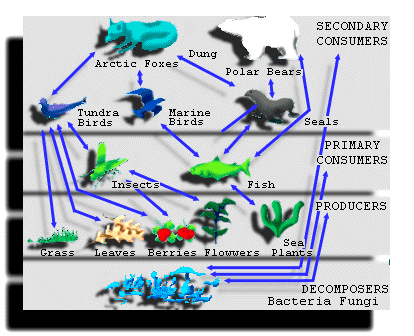
Figure 1: Trophic levels. What happens to the NPP that is produced and then stored as plant biomass at the lowest trophic level? On average, it is consumed or decomposed. You already know the equation for aerobic respiration:In the process, metabolic work is done and energy in chemical bonds is converted to heat energy. If NPP was not consumed, it would pile up somewhere. Usually this doesn't happen, but during periods of earth history such as the Carboniferous and Pennsylvanian, enormous amounts of NPP in excess of consumption accumulated in swamps. It was buried and compressed to form the coal and oil deposits that we mine today. When we burn these deposits (same chemical reaction as above except that there is greater energy produced) we release the energy to drive the machines of industry, and of course the CO2 goes into the atmosphere as a greenhouse gas. This is the situation that we have today, where the excess CO2 from burning these deposits (past excess NPP) is going into the atmosphere and building up over time. But let's get back to an ecosystem that is balanced, or in "steady state" ("equilibrium") where annual total respiration balances annual total GPP. As energy passes from trophic level to trophic level, the following rules apply:
An Example: The Fox and the HareTo understand these rules, we must examine what happens to energy within a food chain. Suppose we have some amount of plant matter consumed by hares, and the hares are in turn consumed by foxes. The following diagram (Figure 2) illustrates how this works in terms of the energy losses at each level.
The hare uses a significant fraction of the assimilated energy just being a hare -- maintaining a high, constant body temperature, synthesizing proteins, and hopping about. This energy used (lost) is attributed to cellular respiration. The remainder goes into making more hare biomass by growth and reproduction (that is, increasing the overall biomass of hares by creating offspring). The conversion of assimilated energy into new tissue is termed secondary production in consumers, and it is conceptually the same as the primary production or NPP of plants. In our example, the secondary production of the hare is the energy available to foxes who eat the hares for their needs. Clearly, because of all of the energy costs of hares engaged in normal metabolic activities, the energy available to foxes is much less than the energy available to hares. Just as we calculated the assimilation efficiency above, we can also calculate the net production efficiency for any organism. This efficiency is equal to the production divided by the assimilation for animals, or the NPP divided by the GPP for plants. The "production" here refers to growth plus reproduction. In equation form, we have net production efficiency = (production / assimilation), or for plants = (NPP / GPP). These ratios measure the efficiency with which an organism converts assimilated energy into primary or secondary production. These efficiencies vary among organisms, largely due to widely differing metabolic requirements. For instance, on average vertebrates use about 98% of assimilated energy for metabolism, leaving only 2% for growth and reproduction. On average, invertebrates use only ~80% of assimilated energy for metabolism, and thus exhibit greater net production efficiency (~20%) than do vertebrates. Plants have the greatest net production efficiencies, which range from 30-85%. The reason that some organisms have such low net production efficiencies is that they are homeotherms, or animals that maintain a constant internal body temperature. This requires much more energy than is used by poikilotherms, which are organisms that do not regulate their temperatures internally. Just as we can build our understanding of a system from the individual to the population to the community, we can now examine whole trophic levels by calculating ecological efficiencies. Ecological efficiency is defined as the energy supply available to trophic level N + 1, divided by the energy consumed by trophic level N. You might think of it as the efficiency of hares at converting plants into fox food. In equation form for our example, the ecological efficiency = (fox production / hare production). Note that the ecological efficiency is a "combined" measure that takes into account both the assimilation and net production efficiencies. You can also combine different species of plants and animals into a single trophic level, and then examine the ecological efficiency of for example all of the plants in a field being fed on my all of the different grazers from insects to cows. Thinking about the overall ecological efficiency in a system brings us back to our first rule for the transfer of energy through trophic levels and up the food chain. In general, only about 10% of the energy consumed by one level is available to the next. For example, If hares consumed 1000 kcal of plant energy, they might only be able to form 100 kcal of new hare tissue. For the hare population to be in steady state (neither increasing nor decreasing), each year's consumption of hares by foxes should roughly equal each year's production of new hare biomass. So the foxes consume about 100 kcal of hare biomass, and convert perhaps 10 kcal into new fox biomass. In fact, this ecological efficiency is quite variable, with homeotherms averaging 1- 5% and poikilotherms averaging 5-15%. The overall loss of energy from lower to higher trophic levels is important in setting the absolute number of trophic levels that any ecosystem can contain. From this understanding, it should be obvious that the mass of foxes should be less than the mass of hares, and the mass of hares less than the mass of plants. Generally this is true, and we can represent this concept visually by constructing a pyramid of biomass for any ecosystem (see Figure 3). 
Figure 3. A pyramid of biomass showing producers and consumers. Pyramids of Biomass, Energy, and NumbersA pyramid of biomass is a representation of the amount of energy contained in biomass, at different trophic levels for a given point in time (Figure 3, above, Figure 4b below). The amount of energy available to one trophic level is limited by the amount stored by the level below. Because energy is lost in the transfer from one level to the next, there is successively less total energy as you move up trophic levels. In general, we would expect that higher trophic levels would have less total biomass than those below, because less energy is available to them.We could also construct a pyramid of numbers, which as its name implies represents the number of organisms in each trophic level (see Figure 4a). For the oceans as shown in Figure 4, the bottom level would be quite large, due to the enormous number of small algae. For other ecosystems, the pyramid of numbers might be inverted: for instance, if a forest's plant community was composed of only a handful of very large trees, and yet there were many millions of insect grazers which ate the plant material. Just as with the inverted pyramid of numbers, in some rare exceptions, there could be an inverted pyramid of biomass, where the biomass of the lower trophic level is less than the biomass of the next higher trophic level. The oceans are such an exception because at any point in time the total amount of biomass in microscopic algae is small. Thus a pyramid of biomass for the oceans can appear inverted (see Figure 4b). You should now ask "how can that be?" If the amount of energy in biomass at one level sets the limit of energy in biomass at the next level, as was the case with the hares and foxes, how can you have less energy at the lower trophic level? This is a good question, and can be answered by considering, as we discussed in the last lecture, the all important aspect of "time". Even though the biomass may be small, the RATE at which new biomass is produced may be very large. Thus over time it is the amount of new biomass that is produced, from whatever the standing stock of biomass might be, that is important for the next trophic level. We can examine this further by constructing
a pyramid of energy, which shows rates of production rather than
standing crop. Once done, the figure for the ocean would have the characteristic
pyramid shape (see Figure 4c). Algal populations can double in a
few days, whereas the zooplankton that feed on them reproduce more slowly
and might double in numbers in a few months, and the fish feeding on zooplankton
might only reproduce once a year. Thus, a pyramid of energy takes into
account the turnover rate of the organisms, and can never be inverted.
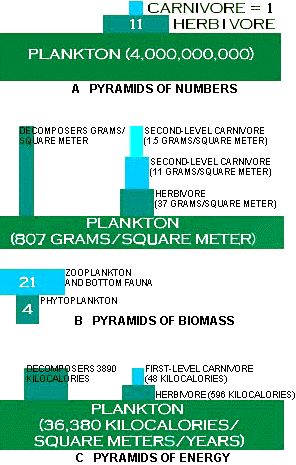
Figure 4: Pyramids of numbers, biomass, and energy for the oceans. We see that thinking about pyramids of energy and turnover time is similar to our discussions of residence time of elements. But here we are talking about the residence time of "energy". The residence time of energy is equal to the energy in biomass divided by the net productivity, Rt = (energy in biomass / net productivity). If we calculate the residence time of energy in the primary producers of various ecosystems, we find that the residence times range from about 20-25 years for forests (both tropical rainforests and boreal forests), down to ~3-5 years for grasslands, and finally down to only 10-15 days for lakes and oceans. This difference in residence time between aquatic and terrestrial ecosystems is reflected in the pyramids of biomass, as discussed above, and is also very important to consider in analyzing how these different ecosystems would respond to a disturbance or what scheme might best be used to manage the resources of the ecosystem. Humans and Energy ConsumptionAll of the animal species on earth are consumers, and they depend upon producer organisms for their food. For all practical purposes, it is the products of terrestrial plant productivity that sustain humans. What fraction of the terrestrial NPP do humans use, or, "appropriate"? It turns out to be a surprisingly large fraction. Let's use our knowledge of ecological energetics to examine this very important issue. (Why NPP? Because only the energy "left over" from plant metabolic needs is available to nourish the consumers and decomposers on Earth.)We can start by looking at the Inputs and Outputs: Inputs: NPP, calculated as
annual harvest. In a cropland NPP and annual harvest occur in the same
year. In forests, annual harvest can exceed annual NPP (for example, when
a forest is cut down the harvest is of many years of growth), but we can
still compute annual averages.
Units: We will use the Pg or Pedagram of organic matter (= 1015 g, = 109 metric tons, = 1 "gigaton") (1 metric ton = 1,000 kg). Table 1 provides estimates of total NPP of the world. There is some possibility that below-ground NPP is under-estimated, and likewise marine NPP may be underestimated because the contribution of the smallest plankton cells is not well known. Total = 224.5 Pg Table 1: Surface area by type of cover and total (from Atjay et al. 1979 and De Vooys 1979).
1. The Low Calculation: (See Table 2)(a) Plant material directly consumed = 5 billion people X 2500 kcal/person/day X 0.2 (to convert kcal -- organic matter) = 0.91 Pg organic matter. If we assume that 17% of these calories derive from animal products, humans directly consume 0.76 Pg of plant matter. Estimate of human harvest of grains and other plant crops is 1.15 Pg annually. This implies loss, spoilage, or wastage of 0.39 Pg, or 34% of the total harvest.
2. The High Calculation: (See Table 3) For the high estimate we now include both co-opted NPP and potential NPP lost as a consequence of human activities: (a) Croplands are likely to be less productive than the natural systems they replace. If we use production estimates from savanna-grasslands, it looks like cropland production is less by 9 Pg. The total for the high
estimate is 58.1 Pg of NPP used, co-opted, or lost. We also must add the
potential NPP to the world estimated NPP before we compute the fraction
appropriated by humans. This gives us 58.1/149.6, or nearly 40% of potential
terrestrial production (about 25 % of terrestrial + aquatic production).
Caveat: These estimates are based on best available data and are approximate.
They probably give the correct order of magnitude.
Additions to Table 3 from processes that co-opt or degrade NPP.
Inferences: What can we conclude from the above analysis of the fate of net primary production in our world?
(a) Human use of marine productivity is relatively small. Moreover, although major fish stocks are heavily fished, and many coastal areas are severely polluted, human impact on the seas is less than on land.
(b) On land, one species, Homo sapiens, commands about 40% of the total terrestrial NPP. This has probably never occurred before in earth's history.
(c) There are many consequences of this co-option of NPP by humans. The consequences include environmental degradation, species extinctions, and altered climate.
(d) Human "carrying capacity" on earth is hard to estimate, because it depends upon affluence of a population and the technology supporting that population. But at present levels of affluence and technology, a population 50 to 100% larger than we have today would push our use of terrestrial NPP to well over 50% of the available production, and the attending degradation of ecosystems on earth (e.g., air and water pollution) would be of major concern. Thus the limits to unchecked growth must be very near. Notice that the lower we "feed" on the trophic chain, the more efficient the web of life becomes -- eating animals that eat animals that eat plants is a very inefficient use of solar energy.
Summary of Part 2, Higher Trophic Levels
Primer on Photosynthesis
Review
Suggested Readings
All materials © the Regents of the University of Michigan unless noted otherwise. |
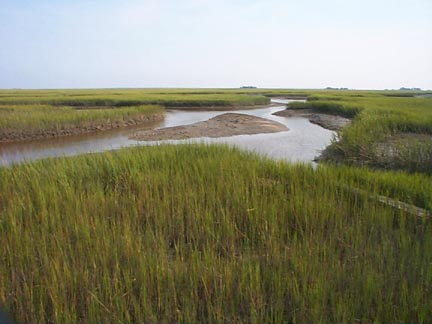
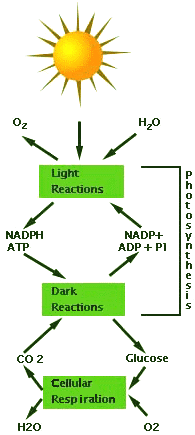 For completeness, we should mention
the pathway known as chemosynthesis. Some producer organisms, mostly
specialized bacteria, can convert inorganic nutrients to organic compounds
without the presence of sunlight. There are several groups of chemosynthetic
bacteria in marine and freshwater environments, particularly those rich
in sulfur or hydrogen sulfide gas. Like chlorophyll-bearing plants and
other organisms capable of photosynthesis, chemosynthetic organisms are
autotrophs (see
For completeness, we should mention
the pathway known as chemosynthesis. Some producer organisms, mostly
specialized bacteria, can convert inorganic nutrients to organic compounds
without the presence of sunlight. There are several groups of chemosynthetic
bacteria in marine and freshwater environments, particularly those rich
in sulfur or hydrogen sulfide gas. Like chlorophyll-bearing plants and
other organisms capable of photosynthesis, chemosynthetic organisms are
autotrophs (see 
